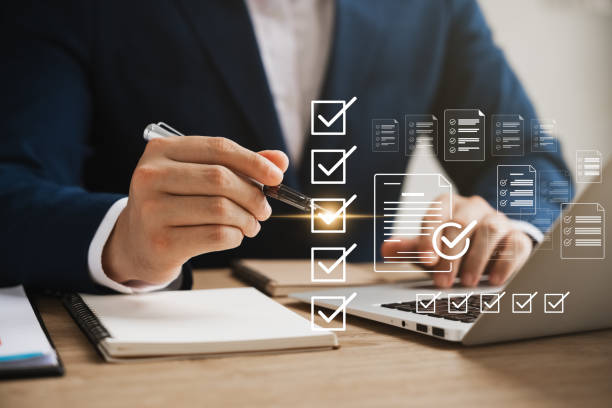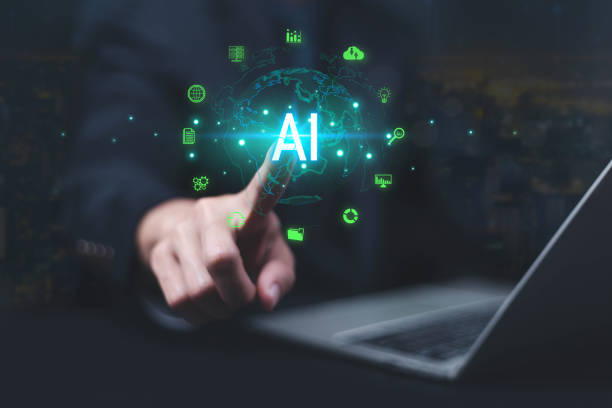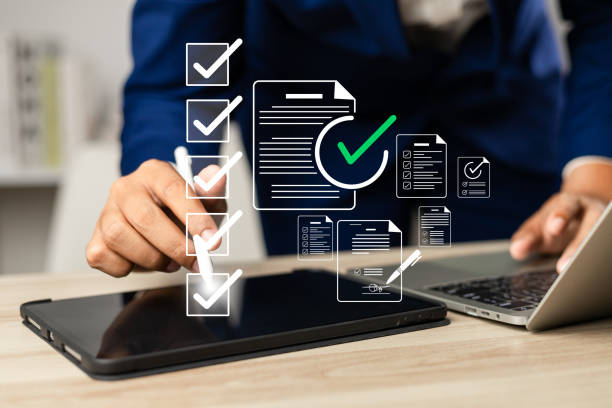### What is On-Page SEO and Why is it Important?
[Image of data insights]
On-Page SEO refers to the set of actions you take within your website to improve your site’s ranking in Google search results (and other search engines).
These actions include optimizing content, HTML code, site structure, and user experience.
The importance of On-Page SEO lies in the fact that it helps search engines better understand the topic and quality of your pages.
In fact, On-Page SEO helps you show search engines what your website is about and why they should rank it in search results.
Proper On-Page SEO is the foundation of a successful SEO strategy, and without it, efforts for Off-Page SEO, such as link building, will not be very effective.
In other words, if your website’s content is not optimized, search engines cannot easily understand its topic, and as a result, they will not give it a good ranking.
On-Page SEO is the foundation for being seen in the online world.
Improving website traffic has a direct relationship with On-Page SEO.
By improving your site’s ranking, traffic from search engines increases, and this increased traffic can lead to increased sales, increased brand awareness, and achievement of your business goals.
On-Page SEO includes optimizing page titles, meta descriptions, heading tags, content, images, internal links, and page loading speed.
> Does your company’s website perform as befits your brand? In today’s competitive world, your website is your most important online tool. Rasaweb, a specialist in professional corporate website design, helps you to:
> ✅ Gain the credibility and trust of customers
> ✅ Convert website visitors into customers
> ⚡ Get a free consultation!
### Keyword Research: Finding Hidden Treasures
[Image of woman working with computer for search management]
Keyword research is the first step in any SEO strategy, including On-Page SEO.
You need to know what words users use to find your products or services.
There are various tools for keyword research, including Google Keyword Planner, Ahrefs, and SEMrush.
Using these tools, you can find keywords related to your business and check their search volume.
It is important to choose words that have a reasonable search volume and are not too difficult to compete for.
Also, pay attention to the variety of keywords and use long-tail keywords as well.
Long-tail keywords usually have a lower search volume, but they have a higher conversion rate because they more accurately address the needs of users.
For example, instead of the keyword “shoes,” use the keyword “buy cheap men’s sports shoes.”
Choosing the right keywords has a significant impact on the success of On-Page SEO and helps you attract more targeted traffic to your website.
### Optimizing Page Title (Title Tag) and Meta Description
[Image of systems applications and products in data process]
The page title and meta description are the first things users see in search results.
The page title should contain the page’s main keyword and briefly describe the page’s topic.
The meta description should also describe the page’s content in an attractive and concise way, encouraging users to click.
Write the page title and meta description in a way that is both attractive to search engines and to users.
The length of the page title should not exceed 60 characters, and the length of the meta description should not exceed 160 characters.
Using keywords in the page title and meta description is very important, but don’t overdo it and try to make the title and description natural and readable.
Optimizing the page title and meta description plays an important role in On-Page SEO and can increase your click-through rate (CTR) and, as a result, improve your site’s ranking.
Click here to preview your posts with PRO themes ››
| Element | Description | Best Practice |
| —————————– | ————————————— | ———————————————— |
| Page Title (Title Tag) | Page title in search results | Contains keyword, maximum 60 characters |
| Meta Description | Brief description of page content | Attractive and persuasive, maximum 160 characters |
### URL Structure: Short, Clear, and SEO-Friendly
[Image of word ftp met vergrootglas 3d rendering]
The URL structure of your website’s pages should be short, clear, and SEO-friendly.
Avoid using long and complex URLs.
URLs should contain keywords related to the page’s content and be easily understandable.
Use a hyphen (-) instead of an underscore (_) to separate words in the URL.
Write URLs in lowercase.
Create a logical and hierarchical URL structure for your website.
For example, instead of the URL “example.com/page123”, use the URL “example.com/blog/seo-guide”.
Optimizing the URL structure is an important aspect of On-Page SEO and helps search engines better understand your site’s structure and index your pages more easily.
> Are you tired of your company’s website not meeting your expectations? With Rasaweb, design a professional website that showcases the true face of your business.
> ✅ Increase new customer acquisition and sales leads
> ✅ Increase the credibility and trust of your brand among audiences
> ⚡ Get a free website design consultation!
### Content Optimization: A Kingdom is Built with Valuable Content
[Image of brand strategy and marketing research]
Content is king! Valuable and high-quality content is the most important factor in On-Page SEO.
Your content should be useful and engaging for users and answer their questions.
Update your content regularly and avoid duplicate content.
Use relevant keywords in your content, but don’t overdo it and try to keep your content natural and readable.
Make your content more engaging by using images, videos, and infographics.
Use heading tags (H1, H2, H3, etc.) to organize your content.
The H1 tag should be the main title of the page, and the other tags should be the subtitles of the page.
Use internal links to connect different pages of your website to each other.
Internal links help search engines better understand your site’s structure and help users navigate your site easily.
### Heading Tags (H1-H6): Structure for Readability and SEO
[Image of vinden van werk concept]
Heading tags (H1 to H6) play an important role in organizing page content and improving On-Page SEO.
The H1 tag should be the main title of the page and should only be used once per page.
Use H2 to H6 tags to create subtitles and divide content.
Using heading tags correctly helps users easily understand the structure of the page and helps search engines better understand the topic of the page.
Use relevant keywords in heading tags, but don’t overdo it and try to make headings natural and readable.
Use heading tags in hierarchical order (i.e., first H1, then H2, then H3, etc.).
Avoid filling the page with unnecessary heading tags.
### Image Optimization: Low Volume, Appropriate Name, Clear ALT Tag
[Image of business concepten met dunne lijnen]
Images play an important role in the attractiveness and efficiency of a website, but if they are not properly optimized, they can reduce page loading speed and negatively impact On-Page SEO.
Reduce image size by using image compression tools.
Use appropriate image formats (such as JPEG for photos and PNG for high-graphic images).
Choose descriptive filenames for images and use relevant keywords.
For each image, write an ALT tag (alternative text) that briefly describes the subject of the image.
The ALT tag helps search engines understand the content of the image and display it in image search results.
Optimizing images helps improve page loading speed and image SEO, and can attract more traffic to your website.
Click here to preview your posts with PRO themes ››
| Image Feature | Description | Best Practice |
| ————- | ———————– | ——————————— |
| Volume | Image file size | Reduce volume with compression |
| Filename | Image filename | Use relevant keywords |
| ALT Tag | Image alternative text | Briefly explain the image’s subject |
### Internal Linking: Creating a Network of Connections
[Image of businessman using computer with seo search engine optimiza]
Internal linking means creating links between different pages of your website.
Internal links help search engines better understand your site’s structure and help users navigate your site easily.
Place internal links strategically in your content and use relevant keywords as link text.
Internal linking helps On-Page SEO and can improve the ranking of your pages in search results.
Avoid creating too many unnecessary links and try to make the links relevant and helpful.
> Are you losing potential customers because of a unprofessional website? Rasaweb is your answer! With our specialized corporate website design services:
> ✅ Enhance the credibility and position of your business
> ✅ Experience attracting more targeted customers
> ⚡ Apply for a free consultation now!
### Page Loading Speed: A Critical Factor in User Experience and SEO
[Image of zoekmachine optimalisatie]
Page loading speed is one of the most important factors in user experience and On-Page SEO.
Users expect web pages to load quickly, and if your page is slow, the chances of users leaving it and going to another site are very high.
Google also considers page loading speed as one of the ranking factors.
To improve page loading speed, optimize your images, use a fast content management system (CMS), use a quality web hosting service, use content delivery networks (CDNs), and optimize your HTML and CSS code.
There are various tools for testing page loading speed, including Google PageSpeed Insights and GTmetrix.
Using these tools, you can identify problems with your page loading speed and take steps to fix them.
### Mobile Optimization: Adapting to a Mobile-Driven World
[Image of business concept social design vector illustrations]
Today, most users access the Internet through mobile devices.
Therefore, optimizing your website for mobile is a necessity.
Your website should be fully compatible with mobile devices and display correctly on small screens.
Use responsive design so that your website automatically adapts to the screen size of the user’s device.
Page loading speed is also very important on mobile.
Make sure your website loads quickly on mobile.
Google also gives a better ranking to websites that are optimized for mobile.
Mobile optimization plays an important role in On-Page SEO and can attract more traffic from mobile devices to your website.
Your website must be mobile friendly.
#### Frequently Asked Questions
| Question | Answer |
| —————————————————————————— | ———————————————————————————————————————————————————————————————————————————————————————————— |
| What is On-Page SEO? | On-Page SEO refers to the set of actions that are done within your website to improve its ranking in search engine results. This includes optimizing content, site structure, and HTML code. |
| Why is On-Page SEO important? | On-Page SEO helps search engines understand your page’s content and determine whether your content is relevant to searchers. It is the foundation of any successful SEO strategy. |
| What are the key elements of On-Page SEO? | Key elements include the page title (Title Tag), meta description, use of keywords, image optimization, heading structure (H1, H2, …), internal linking, and content quality. |
| How to optimize the page title (Title Tag)? | The page title should include the main keyword, be attractive and encouraging to click, and its length should be between 50 and 60 characters (or suitable pixels) to be fully displayed in search results. |
| What role does the meta description play in On-Page SEO? | The meta description is a summary of the page’s content that is displayed below the title in search results. Although it does not directly affect ranking, it helps SEO by increasing the click-through rate (CTR). |
| What is the importance of using the heading structure (H1, H2, H3) in On-Page SEO? | Headings make the content structured and easier to read. H1 is usually the main title of the page and should include the keyword. H2 and H3 are used to organize subsections and help search engines understand the content hierarchy. |
| How to use keywords effectively in content? | Keywords should be used naturally and logically throughout the content, including the introduction, body, and conclusion. Avoid overfilling keywords (Keyword Stuffing). |
| What steps does image optimization for On-Page SEO include? | It includes compressing images to reduce size, using descriptive filenames, adding appropriate Alt Text, and optimizing the image title and description. Alt Text is essential for accessibility and helping search engines understand the content of the image. |
| What is internal linking and what are its benefits? | Internal linking means creating a link from one page on your website to another page on the same website. This helps users easily navigate your site, distributes page authority throughout the site, and helps search engines better understand your site’s structure. |
| What is the importance of content quality in On-Page SEO? | High-quality, accurate, comprehensive, and valuable content for users is the cornerstone of On-Page SEO. Search engines prefer content that meets users’ needs. Quality content leads to longer user dwell time and reduced bounce rate, which are positive SEO signals. |
Click here to preview your posts with PRO themes ››
**And other services of Rasa Web Advertising Agency in the field of advertising**
**Smart advertising campaign: An effective tool to increase sales with the help of dedicated programming.**
**Smart Customer Journey Map: A combination of creativity and technology to increase sales through dedicated programming.**
**Smart Social Media: A new service to increase customer behavior analysis through smart data analysis.**
**Smart Marketing Automation: A dedicated service to grow website visits based on marketing automation.**
**Smart Direct Marketing: A fast and efficient solution for user interaction with a focus on SEO-based content strategy.**
**And more than hundreds of other services in the field of internet advertising, advertising consulting and organizational solutions**
**Internet Advertising | Advertising Strategy | Advertorial Report**
#### Resources
What is On-Page SEO?
, What is On-Page SEO? On-Page SEO Techniques and Tips (2024 Content)
, What is On-Page or Internal SEO? Complete On-Page SEO Training
, What is On-Page or Internal SEO? (Comprehensive Guide + Pictorial Tutorial)
? To be seen and grow your business in the digital world, Rasaweb Afarin is your best companion. From professional WordPress website design to search engine optimization (SEO) and smart social media management, we offer everything you need to shine online with expertise and experience. Let your business shine powerfully on the web and achieve its lofty goals.
📍 Tehran, Mirdamad Street, next to the Central Bank, South Kazerun Alley, Ramin Alley No. 6
✉️ info@idiads.com
📱 09124438174
📱 09390858526
📞 02126406207




